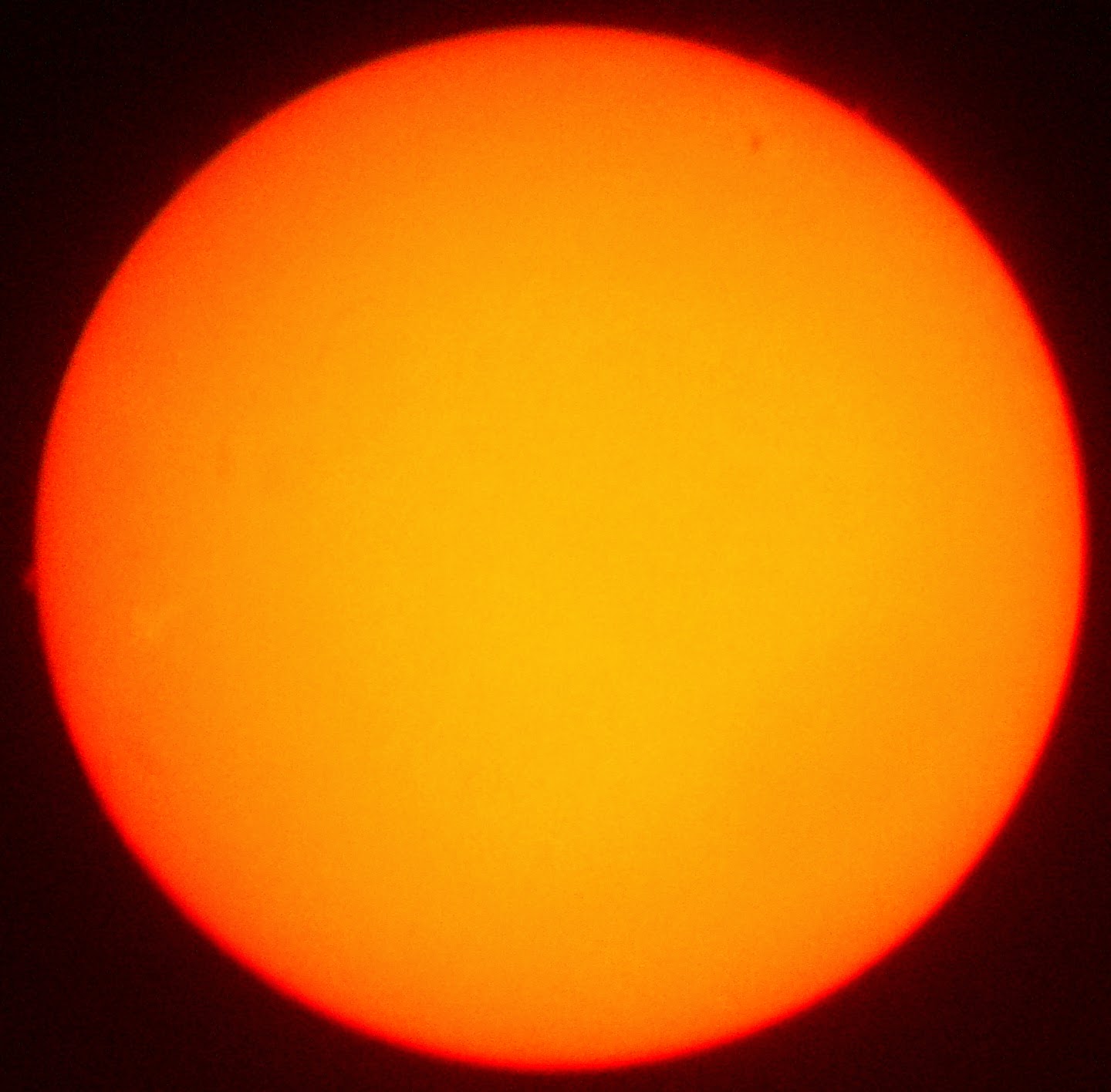I bin scanned the Sun at 1040 GMT but didn't see any sunspots.
October 28th 0950 GMT
October 28th 0800 GMT
After some quite appalling weather, it finally cleared and I had a clear view of the Sun. The sunspots had rotated quite considerably and I saw a new one near the centre of the disc.October 25th 1000 GMT
The bad weather continued but it cleared enough to enable me to see the large sunspot and a couple of nearby smaller ones. It is well possible, though, that there were other sunspots that I missed under the conditions.October 22nd 1030 GMT
Conditions were somewhat worse than my previous viewing, so I was reasonably sure that I had missed some smaller, lighter sunspots. The main group was superb and my drawing skills could not do it justice but conditions did not allow photography.October 20th 1400 GMT
October 19th 1350 GMT
October 19th 2014 0845 GMT
The weather had cleared again somewhat but there was enough moving cloud to dissuade me from any attempts to photograph the Sun. However, it did not stop me from seeing sunspots and some great new activity had rotated on.October 16th 2014 0815 GMT
The apparently interminable bad weather had finally ended to reveal a clear sky but with forecasts of thunderstorms later in the day. I decided to check for sunspots before the bad weather returned.The last quarter moon was high in the west and would have made a great photo opportunity had I not strained my back yet again. I bin scanned it to see Clavius and other southern craters. Copernicus and Kepler were still showing rays and Grimaldi also showed well. Shame I couldn't "snap" it.
October 11th 2014 1545 GMT
October 11th 1210 GMT
I bin scanned the Sun in clear conditions and finally saw a sunspot.
October 10th 0940 GMT
I bin scanned the Sun in clear conditions but did not see a sunspot.
October 9th 1120 GMT
The weather was best described as "changeable". I wanted to do some full disc shots with my PST and follow with some close-ups. Unfortunately, close-ups were cancelled, as cloud moved in. Even though the full disc looked bland in the eyepiece, I was able to capture some prominences "on film" and there was a hint of surface detail but not much.
October 9th 0930 GMT
I bin scanned the Sun under clear conditions but did not see any sunspots.
October 7th 1205 GMT
The Sun was also quiet in hydrogen alpha light and I took just some full disc frames before cloud moved in.
October 7th 1150 GMT
I bin scanned the Sun under clear conditions but did not see any sunspots.
October 7th 0540 GMT
Dawn was well under way but some of the brighter stars were still visible. Betelguese was definitely fainter than Procyon but brighter than Aldebaran. I estimated its brightness at magnitude 0.5.
October 6th 1940 GMT
There was heavy rain in the morning and it cleared after we left for the hospital to see my wife. Fortunately it was clear enough to snap the Moon when we got home.
The full disc shot was 38 out of 52 frames but did not get rid of the lens blemish.
I tried a few frames in the Tycho region and stacked 16 of 29 frames.
Finally, I stacked 4 of 13 frames to capture Plato.
October 5th 1015 GMT
I bin scanned the Sun under poor conditions and did not see any activity.
October 4th 1930 GMT
I took some full disc shots of the Moon and stacked 27 of 35 to get a half decent result. I tried similar efforts at close-ups but managed only one image of each region I tried. Scintillation was just too much, with the Moon quite low in the sky.
October 3rd 1245 GMT
It cleared enough to see the Sun in hydrogen alpha light and
there were many groups of prominences.
October 3rd 1045 GMT
October 2nd 0945 GMT
Conditions were certainly no better than the day before but
this time I was able to see a single sunspot in a position consistent with one
where I had seen 3 together 2 days before. It is highly likely that I would
have missed any fainter sunspots. The Sun was still surprising me!
October 1st 1255 GMT
There was a little bit of Sun through thin cloud but I could
not see any sunspots. I figured that the larger ones had rotated from view and
it was too cloudy to see the fainter ones.





































No comments:
Post a Comment